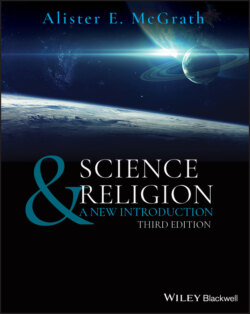Читать книгу Science & Religion - Alister E. McGrath - Страница 8
The Chessboard: The Diversity of Science and Religion
ОглавлениеMany rightly express a concern about the coherence of the field of science and religion. Is it conceptually integrated – or is it just a sprawling mass of disconnected debates and discussions, gathered together for the sake of convenience under the loose framework of ‘science and religion’? This is a fair point to raise, given the diversity of individual sciences and religions, and the multiplicity of their possible interactions.
The term ‘science’ is often used to designate the overall empirical and theoretical enterprise that lies behind or is enfolded within the various scientific disciplines – such as chemistry, biology, and psychology. Yet these are individual sciences, which have their own distinct research methods, histories, and professional communities of interpretation and application. The uncritical use of the more general term ‘science’ flattens the landscape of the natural sciences, failing to do justice to the distinctiveness of each individual science.
‘Religion’ is not a well‐defined category and is thus resistant to rigorous definition. Scholars working in the field of the psychology of religion and other empirical approaches to religious thought and behaviour constantly find themselves frustrated by the lack of an agreed empirical definition of religion. To name one obvious problem: if religion is defined in terms of belief in a god or god(s), this excludes one of the world's major religions – Buddhism. Religion is not an empirical concept, but a socially constructed notion. We might agree that there are individual ‘religions’ – such as Islam, Judaism, and Buddhism – but this does not mean that there exists some universal essential category of ‘religion’ which each exemplifies in its own distinct way.
There is now a general consensus that it is seriously misleading to regard the various religious traditions of the world as variations on a single theme. During the early 1960s, for example, the Canadian Islamic scholar Wilfred Cantwell Smith argued that religions do not possess some common defining feature that is captured and expressed by the term or underlying category of ‘religion’. Rather, Smith argued, the concept of ‘religion’ was created by modern Western scholars and superimposed upon a variety of phenomena, thus creating the misleading impression of some underlying universal concept of ‘religion’.
It is also important to appreciate that, in addition to clear differences across the world's religions, there are also significant variations within individual religious traditions, such as Christianity. Conservative Protestants and liberal Catholics are likely to hold very different views on Charles Darwin's theory of natural selection. So can one of these alone be identified as ‘the Christian view’, which is somehow to be seen as normative within a religion? Or must we learn to acknowledge a diversity of views within a single religious tradition? Perhaps the wisest approach is simply to respect the integrity of religious traditions and movements within such traditions, rather than to attempt to homogenize their ideas or force them into some artificial common mould. The complexity of modern Buddhism, Christianity, Islam, and Judaism is such that it is intellectually precarious to generalize about them without acknowledging debate and diversity within them.
Yet perhaps the most obvious difficulty with the field of science and religion is that it designates such a broad field that it runs the risk of becoming meaningless and useless. Which science? Which religion? If the field of ‘science and religion’ claims to represent all sciences and all religions, it becomes unmanageable and incoherent, given the diversity and complexity of both specific scientific disciplines and specific religious traditions.
In discussing this point with students at Oxford, I have found the analogy of a chessboard to be helpful. A chessboard has multiple spaces (in this case, 64) – but they are not all occupied. The field of science and religion, at least in theory, offers a vast array of intellectual possibilities – such as the relation of Buddhism and Psychology, or Islam and Biology. Yet not all of these possibilities have attracted intellectual attention. Some spaces are packed full of researchers, scholars, and interested readers; others are virtually empty. Examples of highly populated areas of interest within this field include:
The Natural Sciences and Arguments for the Existence of God;
The Significance of Darwinism for Religious Belief.
Yet other areas, despite clearly being of intellectual interest, remain understudied. Christianity remains the religious tradition whose engagements with science have been most widely discussed within the ‘science and religion’ community, and many highly populated spaces on the chessboard specifically engage this religious tradition, particularly in relation to historical questions, such as the relation of Christianity and the origins of the scientific revolution in western Europe.
The chessboard model helps us visualize the extensive field of science and religion, and identify the spaces that have dominated discussion within the field – and which thus need to be included within this book. Given that this work is intended to serve as a textbook, it is clearly important to map its contents onto both scholarly activity within the field, and popular interest in the field. This work thus engages the most highly populated squares on the chessboard, while recognizing that there are other areas of legitimate intellectual interest which have not yet secured the attention that they deserve.
